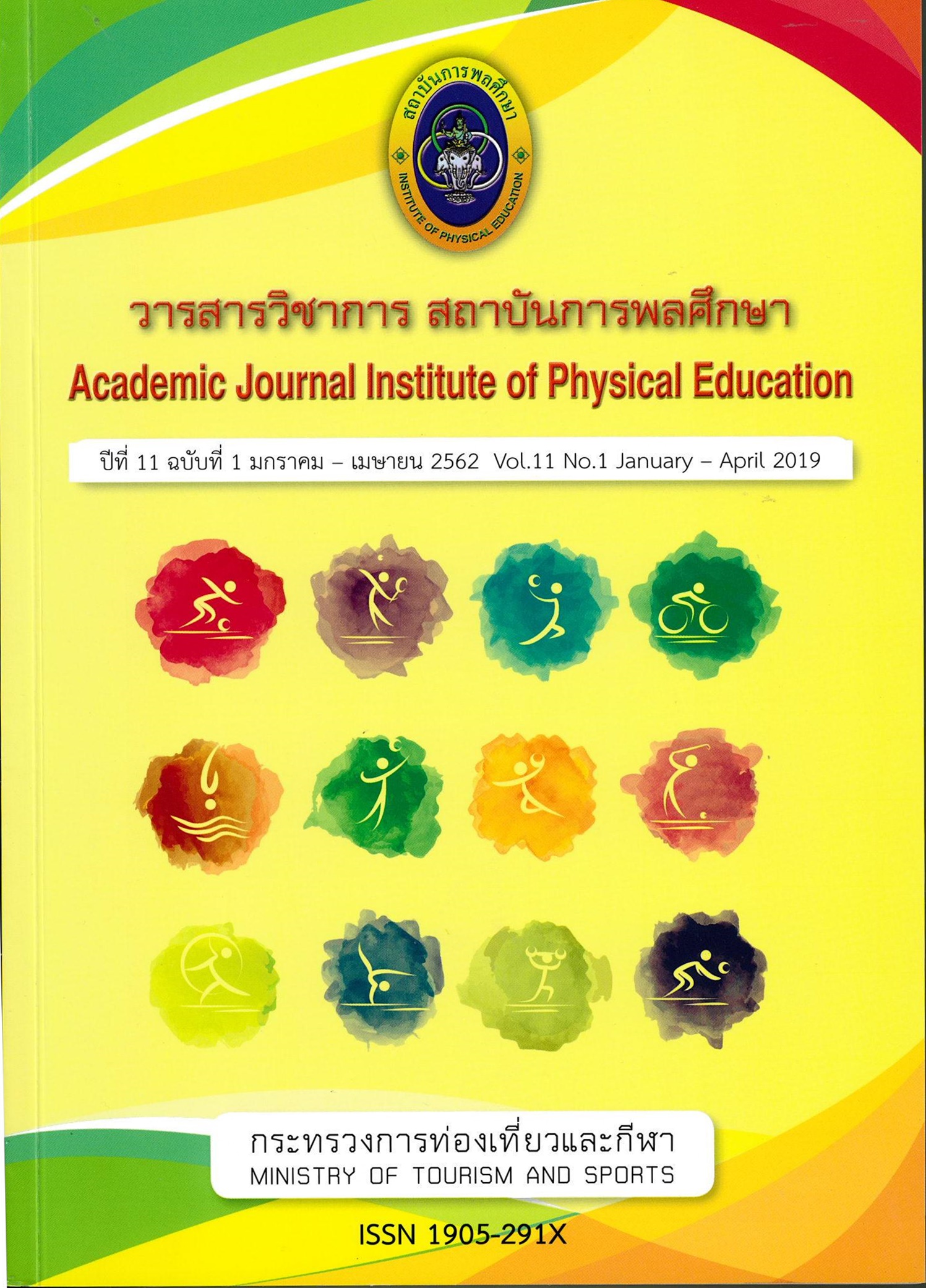Mental Therapy in a Football Player Getting the Acl Knee Surgery with Imagery Affecting Levels of Physical and Psychological States and Pain Reliever Intake: a Case Study
Main Article Content
Abstract
The current study aimed to compare quality of life, anxiety, confidence, the perception of pain, the perception of muscle tension and pain reliever intake between after baseline- and post-conditions in football player, using visual analysis of graphs. Participants (P): Participant was male professional football player who had a symptom of abnormal-shape anterior cruciate knee ligament (Grade II), 20 years of age. He got the ACL surgeries at two knees for two times, and volunteered for this study. Tools: Research tools were 1) The Measure of Physical and Psychological States for Sport Injury [except “pain experienced during sport” and “muscle tension experienced during sport”], and 2) an imagery intervention on emptiness state, designed as followed an imagery of warmth (Bhasavanija, & Morris, 2015). Data analysis: Comparison of levels of quality of life, anxiety, confidence, the perception of pain, the perception of muscle tension, and pain reliever intake between after left-knee getting surgery (baseline data) and right-knee getting surgery (post-test data), using visual analysis of graphs.
Results found that after right knee getting surgery using the medical treatment together with imagery of emptiness state, participant showed higher level of quality of life and confidence, as well as lower levels of anxiety, the perception of pain, the perception of muscle tension, and pain reliever intake than after left knee getting surgery, apart 12 weeks. This study suggests that doing the emptiness state imagery can help one to blank pain symptom. This mental program should be not only taking into account for conventional medicine or alternative medicine, but also probably be applied for sport in order to enhance performance and/or reduce anxiety, stress, and frustration
Article Details
The published article is a copyright of the Academic Journal of Thailand National Sports University. The passage appeared in each article in this academic journal is a perspective of each author which is not related to the journal. Each author is required to be responsible for all components of his/her own article. If there are any mistakes, each author must be responsible for those mistakes on his/her own.
References
คัคนางค์ ประไพทรัพย์, ศิริวรรณ ชอบธรรมสกุล, กรสรวง ปาณินท์, พนัชกร ภวภูตานนท์ ณ มหาสารคาม, และ กฤชญา พุ่มพิน. (2560). อุณหภูมิรางกาย และการรับรู้ความอ่อนล้าของกล้ามเนื้อในนักศึกษาต่างชาติชาวเอเชีย ขณะทำการพักการฝึกกิจกรรมทางกายนาทีที่ 20 และนาทีที่ 50 และการฝึกการจินตภาพ. การประชุมวิชาการระดับชาติ ทางจิตวิทยา: ชีวิตดี เปลี่ยนได้ ด้วยศาสตร์แห่งใจ. หน้า 313-323.
ธิรตา ภาสะวณิช. (2559). จิตวิทยาการกีฬา PED4303. กรุงเทพมหานคร: โรงพิมพ์มหาวิทยาลัยรามคำแหง.
ธิรตา ภาสะวณิช, เจษฎา เจียระนัย, เดชศักดิ์ จันทรสวัสดิ์, และ อลิสา นิติธรรม. (2547). โปรแกรมฝึก การควบคุมความตั้งใจสำหรับนักกอล์ฟระดับเริ่มเล่น. วิทยานิพนธ์ปริญญาโท สาขาพลศึกษา คณะศึกษาศาสตร์ มหาวิทยาลัยเกษตรศาสตร์.
ปัญญา พุดซ้อน, มณเฑียร อยู่เย็น, อุมาพร งามมีฤทธิ์, วัชระ รุ่งสว่าง, และ ผกามาศ รัตนบุษย์. (2560). แนวโน้มของอัตราการเต้นของหัวใจ และการรับรู้ความอ่อนล้าของกล้ามเนื้อ ขณะทำการพักการฝึกกีฬายิมนาสติกที่เวลา 20 นาที และ 40 นาที และการฝึกการจินตภาพเกยวกับความอบอุ่น. การประชุมวิชาการระดับชาติทางจิตวิทยา: ชีวิตดีเปลี่ยนได้ด้วยศาสตร์แห่งใจ.
Adams, D., Logerstedt, D., Hunter-Giordano, A., Axe, M.J., & Snyder-Mackler, L. (2012). Current concepts for anterior cruciate ligament reconstruction: A criterion-based rehabilitation progression. Journal of Orthopedics Sport Physiology Therapy, 42(7), 601-614.
Anastasi, A. (1988). Psychological testing. (6th ed.). New York: Macmillan.
Bhasavanija, T., Chirathamawat, P., Chobthamasakul, C., & Poompin, K. (2015). Validation of the Physical and Psychological State Measure in Sport for Thai athletes. Proceedings: The 2nd International Seminar in Exercise and Sport Psychology. Burapha University.
Bhasavanija, T., & Kuan, G. (2017). The effect of warmth imagery on physiological, physical and psychological states among injured youth sepaktakraw athletes: a case study design. International Journal of Sport, Exercise and Health Research, 1(1), 46-53.
Bhasavanija, T., & Morris, T. (2015). Muangthong United football players’ recovery from football matches using a warmth imagery intervention. Proceedings: The 1st Malaysian.
Bhasavanija, T., Vongjaturapat, N., Morris, T., & Muangnapo, P. (2010). Imagery training to increase hand warmth in golfers. Proceedings: Taiwan International Congress in Sport Psychology. Taipei, Taiwan: ASPASP.
Breakwell, G.M., Hammond, S., & Fife-Schaw, C. (2000). Research methods in psychology. (2nd ed.). London : SAGE. p.60.
Cox, R.H. (2002). Sport Psychology: Concepts and Application. (5th ed.). New York: The McGraw – Hill Companies, Inc.
Smith, B.D. (1998). Psychology Science Understanding. New York : The McGraw – Hill Companies, Inc.
Thammatipo, T. (2004). Mental depth causing unconsciousness. Bangkok: Mental Development Centre, Education Ministry of Thailand, p.15.
Vander, A.J., Sherman, J.H., & Luciano, D.S. (1990). Human Physiology: The Mechanisms of Body Function. 5th Ed., Caledonia: York Graphic Services, Inc.


